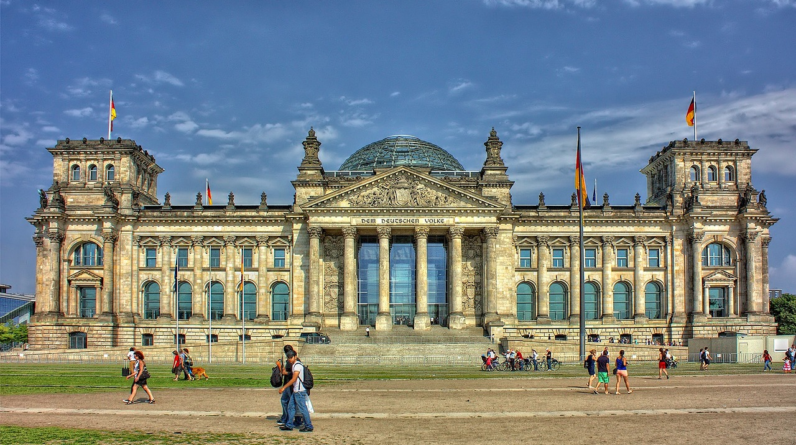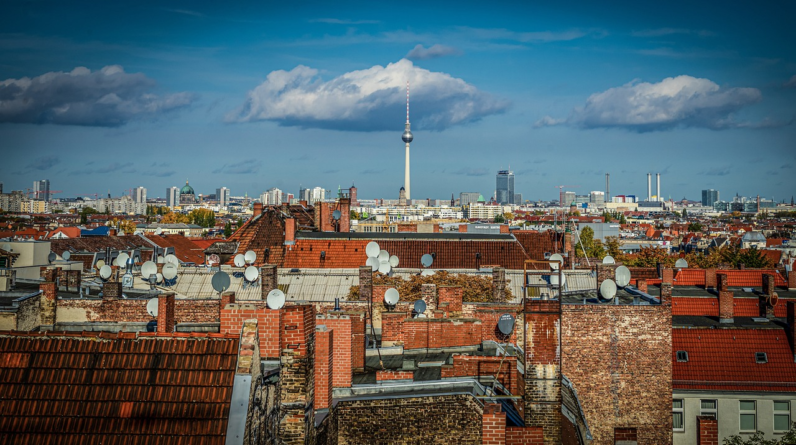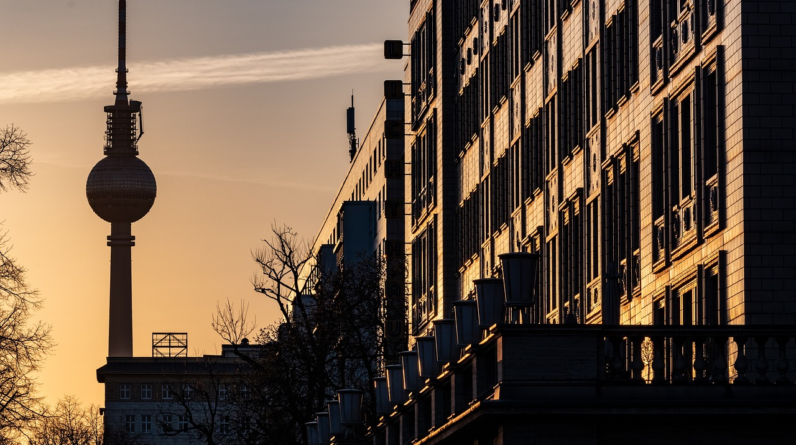
If you’re a history buff and looking to explore the dark past of Berlin during World War II, then there are several must-see sites that you simply can’t miss. From concentration camps to memorials, these locations offer an insight into the atrocities committed during this time and stand as a reminder of the importance of never forgetting such events.
One of the first stops on your journey should be the Topography of Terror, which sits on the site where the Gestapo headquarters once stood. This museum provides detailed information about the regime’s rise to power, their methods for controlling and terrorizing their citizens, and ultimately their downfall.
It’s a sobering experience that is sure to leave an impression and help you understand better how World War II affected those living in Germany at that time.
Topography of Terror
The Topography of Terror provides a thought-provoking glimpse into the tumultuous history of this city. As you walk through the remains of the Nazi regime’s headquarters, you can see how architecture and history were used to create an atmosphere of fear and intimidation.
The exhibition also delves into the propaganda tactics employed by the regime to manipulate public opinion and suppress dissent. One striking feature is the preserved section of the Berlin Wall, which serves as a reminder that Germany was once divided by ideology and power struggles.
Visitors can learn about the different methods used to control people’s lives, such as censorship, surveillance, and persecution. It’s a sobering experience that highlights how easily human rights can be trampled upon when unchecked power is allowed to run rampant.
Memorial to the Murdered Jews of Europe
As you approach the Memorial to the Murdered Jews of Europe, take a moment to reflect on the unimaginable horrors of the Holocaust. The emotional impact of walking through a sea of concrete slabs is sure to leave a lasting impression.
Take time to learn about the lives of Jewish victims and honor their memory at this powerful memorial.
Reflect on the Holocaust
Reflecting on the Holocaust can be a heart-wrenching experience, but it’s important to remember and honor those who suffered during this dark chapter in history.
Contemplating remembrance means acknowledging the gravity of what happened and recognizing the magnitude of loss that occurred. It requires taking a moment to pause and reflect on how this event impacted not just the lives of those directly affected, but also the world as a whole.
As visitors make their way through the Memorial to the Murdered Jews of Europe, they’re reminded of their historical responsibility to never forget what took place in Berlin during World War II.
The memorial serves as a solemn reminder that we must always strive towards peace and tolerance, so that such atrocities may never occur again. It’s only by reflecting on our past mistakes that we can hope to create a better future for all people, regardless of race or religion.
Experience the Emotional Impact of the Concrete Slabs
You can feel the emotional weight of the concrete slabs as you walk through the Memorial to the Murdered Jews of Europe in Berlin. The stark, gray slabs are arranged in a grid pattern over an area of 19,000 square meters. As you make your way through them, the ground slopes and dips so that you’re not always walking on level ground. It’s disorienting and unsettling – just like how it must have felt to be a victim during World War II.
The memorial is meant to reflect on the Holocaust and provide understanding through education. There’s an underground information center where visitors can learn about individual victims, read letters and diaries from survivors, and watch video testimonials. Reflecting through art is also a theme here: there’s an exhibit space for contemporary artists whose works address issues related to genocide and persecution around the world.
Visiting this memorial is a powerful experience that will leave you with much to contemplate long after you’ve left Berlin.
Learn about the Lives of Jewish Victims
Explore the stories of Jewish victims and gain a deeper understanding of their lives at this poignant memorial.
The Jewish Museum Berlin offers an extensive collection of exhibits that showcase the cultural, political, and social history of Jews in Germany from the Middle Ages to the present day.
You can walk through rooms dedicated to different themes, including immigration, family life, and religious traditions.
You’ll also have the opportunity to hear survivor stories firsthand through audio recordings and personal accounts.
One exhibit you won’t want to miss is ‘The Holocaust’ room, which displays photos, documents, and artifacts related to Nazi persecution of Jews during World War II.
This powerful exhibit is designed to evoke emotions and provoke thought about this dark period in history.
Through exploring these exhibits and hearing survivor stories, you’ll gain a greater appreciation for the resilience of Jewish people in the face of adversity.
Reichstag Building
You’ll want to check out the Reichstag Building, a historical landmark that played a significant role in shaping German politics and history. The glass dome at the top of the building is an iconic symbol of Berlin and represents transparency in government. You can explore the architecture and learn about the history of this impressive structure through a guided tour.
One of the highlights of visiting Reichstag Building is admiring the cityscape view from its rooftop terrace. From here, you can see many famous landmarks, including Brandenburg Gate and Tiergarten Park. It’s not just a stunning view – it also provides insight into how Berlin has evolved over time.
If you’re interested in seeing where modern Germany’s political landscape began, make sure to add this stop to your itinerary when exploring World War II sites in Berlin.
Berlin Wall Memorial
Immerse yourself in the rich history of a divided city by visiting the Berlin Wall Memorial. This site is a poignant reminder of the struggles that Berlin faced during World War II, when it was split into two separate states.
As you explore the memorial, you’ll gain a deeper understanding of how people fought for their freedom against all odds. The Berlin Wall Memorial is not only a place to learn about history but also an opportunity to pay respect to those who sacrificed so much for their beliefs.
You can walk along the preserved section of the wall and see firsthand how it once separated families and friends. The memorial also includes exhibits that provide further context and information about life on both sides of the wall.
By visiting this important site, you can honor those who fought for freedom while gaining a new appreciation for what it means to live in a united society.
Sachsenhausen Concentration Camp
You’ll experience the haunting site of Sachsenhausen Concentration Camp, a former Nazi prison camp.
As you walk through the remains of the camp, you’ll learn about the lives of prisoners and their daily struggles.
Reflect on the atrocities committed during World War II as you witness the memorial’s somber reminders of humanity’s darkest moments.
Experience the Site of a Former Concentration Camp
Take a sobering journey through the remains of a concentration camp and gain an understanding of the atrocities that occurred during this dark period in history. Experience the site of a former concentration camp, where interactive exhibits and survivor stories provide insight into what life was like for those who were imprisoned there.
Learn about the horrors that took place within these walls and reflect on how we can apply lessons from this tragic chapter in history to modern day issues.
Walking through the grounds of a former concentration camp is an emotional experience that will stay with you long after you leave. The exhibits allow visitors to learn about the lives of those who were imprisoned there and gain a deeper understanding of the impact that these camps had on individuals, families, and communities.
By learning from history, we can work towards creating a better future for all people, free from oppression and discrimination.
Learn About the Lives of Prisoners
You can learn so much about the lives of prisoners at this former concentration camp. The exhibits and survivor stories provide a glimpse into the daily struggles and incredible resilience of those who were imprisoned here.
As you walk through the barracks and see the cramped living conditions, you can start to understand just how difficult life was for these prisoners.
The historical context is also important to consider when learning about prisoner experiences. Understanding the political climate that led to their imprisonment and the atrocities committed against them helps contextualize their stories.
It’s a sobering reminder of what humans are capable of doing to each other, but it also highlights the strength of those who managed to survive and persevere.
Reflect on the Atrocities Committed During World War II
Reflecting on the atrocities committed during WWII is a chilling reminder of the horrific actions humans are capable of when consumed by hate and prejudice.
As you visit the various sites in Berlin that pay tribute to those who suffered and lost their lives during the war, it’s important to take a moment and reflect on the weight of history.
The Holocaust Memorial, for example, with its rows upon rows of towering concrete slabs, serves as a sobering reminder of the millions who were systematically murdered by the Nazi regime.
But beyond simply mourning these losses, there are contemporary implications that make this reflection all the more vital.
The rise of far-right extremism across Europe and North America underscores how easily prejudice can take hold and spread even in modern times.
By educating ourselves about the historical events that led to WWII and its aftermath, we can better equip ourselves to recognize dangerous ideologies before they have a chance to gain traction.
In this way, visiting these sites isn’t just a matter of paying respects – it’s an opportunity for personal growth and vigilance against similar tragedies in our own time.
Frequently Asked Questions
How many people were killed in the Holocaust in Berlin?
If you’re interested in learning about the Holocaust in Berlin, there were approximately 55,000 Jews who were killed during this tragic period.
Today, there are several Holocaust memorials and remembrance events throughout the city that honor those who lost their lives.
One of the most prominent memorials is the Memorial to the Murdered Jews of Europe, which is located in central Berlin. This massive installation features 2,711 concrete slabs of varying heights that create a haunting and somber atmosphere.
There’s also the Topography of Terror museum, which chronicles Nazi atrocities and provides a sobering look at this dark chapter in German history.
Overall, visiting these sites can be an emotional but important way to pay tribute to those who suffered during one of humanity’s greatest tragedies.
What percentage of the city was destroyed during the war?
During World War II, Berlin suffered significant destruction. It’s estimated that up to 80% of the city was destroyed during the war. The reconstruction efforts were massive and took decades to complete.
While much of the focus is on the impact on civilian life during the war, it’s important to note that the post-war years were also a time of great hardship for Berliners. The city had to be rebuilt from scratch, and this was no easy feat given its size and complexity. Despite these challenges, however, Berlin has managed to rise again as one of Europe’s most vibrant and exciting cities today.
What other cities in Germany were heavily bombed during World War II?
If you’re interested in learning about the impact of World War II on Germany beyond Berlin, there are several other cities worth exploring. Many German cities were heavily bombed during the war, including Dresden, Hamburg, Cologne, and Frankfurt.
These cities faced significant challenges in rebuilding efforts after the war due to extensive damage. However, despite these obstacles, each city has managed to rebuild and preserve its cultural heritage.
Today, visitors can explore historic sites and museums that showcase the impact of the war on these cities and their people.
What was the role of the Hitler Youth in Berlin during the war?
If you’re interested in the history of World War II and Nazi Germany, you may want to know more about the role that the Hitler Youth played in Berlin during the war.
The Hitler Youth was a youth organization established by Adolf Hitler in 1922, aimed at indoctrinating young people with Nazi ideology and preparing them for military service.
In Berlin, the Hitler Youth had a strong presence and engaged in various activities such as military training, political education, and propaganda dissemination. They were also involved in supporting the war effort through fundraising campaigns and other initiatives.
The group’s influence on young people was immense, as they were taught to idolize Hitler and embrace his vision of a pure Aryan society.
Despite its controversial legacy, exploring the impact of the Hitler Youth activities and propaganda influence can provide valuable insights into one of the darkest periods of human history.
How did the city’s infrastructure and economy recover after the war?
After the devastation of World War II, Berlin faced massive rebuilding efforts to restore its infrastructure and revive its economy. The city’s post-war recovery was driven by a combination of government investment, private enterprise, and international aid.
Despite the challenges posed by the Cold War and the division of Germany, Berlin managed to emerge as a thriving metropolis with a diverse economy that includes finance, technology, tourism, and cultural industries.
Today, visitors to Berlin can witness firsthand how the city has transformed over the decades from a war-torn ruin into a vibrant hub of European commerce and culture.
Conclusion
In conclusion, visiting the World War II sites in Berlin will give you a firsthand experience of the atrocities that took place during that time. The Topography of Terror provides a historical perspective on how Nazi Germany rose to power and carried out their plans of genocide.
The Memorial to the Murdered Jews of Europe is a moving tribute to those who lost their lives during the Holocaust. The Reichstag Building represents both the destruction and reconstruction of Germany and serves as a symbol of democracy.
The Berlin Wall Memorial is a reminder of the division caused by the Cold War and how it impacted people’s daily lives. Finally, Sachsenhausen Concentration Camp offers an educational insight into Nazi oppression and cruelty towards prisoners.
Exploring these sites will not only deepen your understanding of history but also serve as a reminder to never forget what happened during this dark period. It’s important to honor the victims and acknowledge our responsibility to prevent similar atrocities from happening again in the future.
Therefore, make sure to include these places in your itinerary when visiting Berlin for an unforgettable experience that’ll leave you with a greater appreciation for humanity’s resilience in times of adversity.







